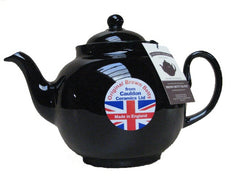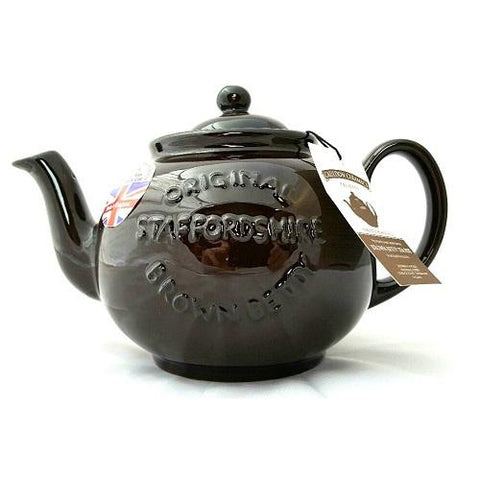 In the Midlands of England, around 160 miles northwest of London, lies the city of Stoke-on-Trent. This piece of Staffordshire, which has earned the epithet “The Potteries”, has been the focal point of English earthenware making since the Middle Ages. The characteristic assets important to make ceramics—earth, lead, salt, and coal—are found in plenitude here. In the 18th and 19th companies like Wedgwood, Spode, and Royal Doulton, produced Staffordshire stoneware teapots and teacups to the same standards as Chinese porcelain, which was the industry leader at that time.
In the Midlands of England, around 160 miles northwest of London, lies the city of Stoke-on-Trent. This piece of Staffordshire, which has earned the epithet “The Potteries”, has been the focal point of English earthenware making since the Middle Ages. The characteristic assets important to make ceramics—earth, lead, salt, and coal—are found in plenitude here. In the 18th and 19th companies like Wedgwood, Spode, and Royal Doulton, produced Staffordshire stoneware teapots and teacups to the same standards as Chinese porcelain, which was the industry leader at that time.
Bona fide Brown Betty teapots will state "Made in England" on the base.
 By the start of the 19thcentury, tea drinking had spread all through all levels of British society, and each British home, regardless of how modest, had its own teapot. While women in high-class drawing rooms and British nation houses served tea in Josiah Spode's new bone china teapots, the teapot of decision for ordinary people was the Brown Betty.
By the start of the 19thcentury, tea drinking had spread all through all levels of British society, and each British home, regardless of how modest, had its own teapot. While women in high-class drawing rooms and British nation houses served tea in Josiah Spode's new bone china teapots, the teapot of decision for ordinary people was the Brown Betty.
The vessels were initially made as everyday objects which can be used a few times each day and be easily replaced when broken. To be sure, the Brown Betty has turned out to be one of the most celebrated pieces of earthenware created in Staffordshire. Generations of Englishmen believe that this teapot makes the best pot of tea on the planet, and they could conceivably be correct.
 Some reasons why the Brown Betty is Unique. The red clay only found in Staffordshire retains heat better than any other clay, which ensures your tea will remain hot for several "cuppas."
Some reasons why the Brown Betty is Unique. The red clay only found in Staffordshire retains heat better than any other clay, which ensures your tea will remain hot for several "cuppas."- As hot boiling water is poured into the Brown Betty Teapot, its rounded shape makes loose tea leaves swirl gently around, creating a perfect blend.
- The Rockingham glaze, which is a dark manganese glaze, gives the Brown Betty its unique color and doesn’t show tea stains over time—It was a definite advantage for Victorian housewives for easy cleaning; just rinse the teapot with warm water, after tea time and upend it in the dish drain to dry.
 In the past few years, Brown Betty teapots were thrown on a potter’s wheel, and the handle and spout were added after then. But nowadays, the slip-casting method is used, in which a suspension of clay in water is transferred into a mold. Once the teapot is set and got its shape, then it’s taken out from the mold and left to dry naturally. Then the teapot is fettled and put it in the furnace for the first time.
In the past few years, Brown Betty teapots were thrown on a potter’s wheel, and the handle and spout were added after then. But nowadays, the slip-casting method is used, in which a suspension of clay in water is transferred into a mold. Once the teapot is set and got its shape, then it’s taken out from the mold and left to dry naturally. Then the teapot is fettled and put it in the furnace for the first time.
Now the teapot is dipped into the Rockingham glaze and, once again, left to dry naturally. (The dipped pots are a pretty lavender color.) The teapot is then foot-wiped to remove any glaze from the bottom and is fired a second time to get the glossy brown chocolate-syrup-like surface that distinguishes Brown Bettys.
Over the centuries, several companies of Stoke-on-Trent have made Brown Betty teapots. It is still possible to have vintage teapots from the1940s and 1950s, having names such as Sadler or Alcock, Lindley &Bloore for sale in antique shops or for auction on eBay. These companies had left the business a time ago.
Now, Cauldon Ceramics are the exclusive makers of Original Brown Betty Teapots.
You could say that when you serve tea in an authentic Brown Betty Teapot, you are actually holding in your hand a piece of British History.
For getting a little piece of British history to your home please click the link- Cauldon Ceramics

Thank you for this information. I’ve been searching for one for quite some time, and I finally found one today at a secondhand store, and I was so excited. I’m excited to brew my first pot of tea in it. Thank you for the information again.